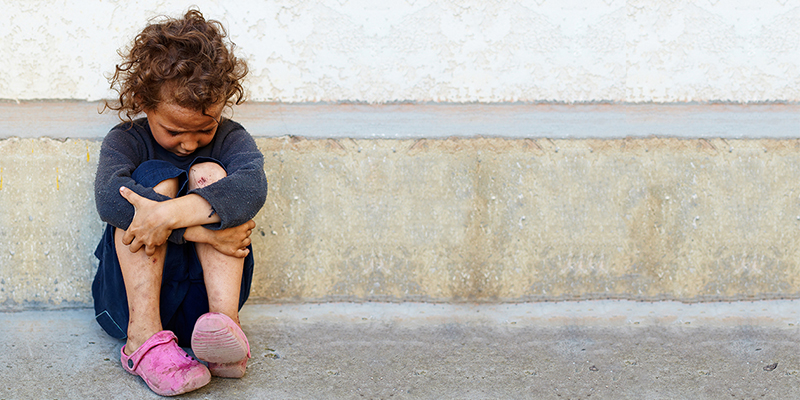Poverty combined with crowded housing or parental separation pose highest risks

Poverty, combined with other types of adversity in early childhood, is associated with greater chances of premature death in adulthood, compared to other adverse childhood experiences, according to a study of more than 46,000 people by researchers at the National Institutes of Health.
Compared to children who did not experience early life adversity, childhood poverty combined with crowded housing was associated with a 41% higher risk for premature death, and early poverty combined with separation from a parent was associated with a 50% increase in premature death. Those who experienced parental harshness and neglect had a 16% higher risk of premature death, and those who experienced family instability had a 28% higher risk for premature death.
The findings build upon earlier studies that linked individual types of adverse childhood experiences to risk of death, as well as other studies that demonstrated that death risk rose as exposure to childhood adversity increased. The current study identifies links between combinations of early childhood adversity and the overall chances of premature death.
“Understanding how patterns of early childhood adversity are associated with shortened life expectancy helps us better understand the toll of early experiences on human health and the extent that this toll carries over from childhood through adulthood,” said the study’s senior author, Stephen E. Gilman, Sc.D., chief of the Social and Behavioral Sciences Branch at NIH’s Eunice Kennedy Shriver National Institute of Child Health and Human Development (NICHD). “In the long run, we hope that results such as ours can inform efforts to develop better interventions that would both reduce exposure to childhood adversity and reduce the health consequences of early adversity among exposed children.”
The study, conducted by investigators Jing Yu, Ph.D., Dr. Gilman and other NICHD colleagues, appears in The Lancet Regional Health – Americas.
The study participants were offspring of mothers who enrolled in the Collaborative Perinatal Project, a study on maternal and child health conducted by NIH. The researchers compared data from death records compiled from 1979 to 2016 to data that assessed the children’s experiences from when they were born, from 1959 to 1966, through age 7. Among the 46,129 study participants in the analysis, 3,344 deaths occurred. Based on questionnaire information and other data collected from the participants’ mothers, the researchers developed five classifications of early childhood adversity:
- Low adversity: unlikely to have experienced any significant childhood adverse events (48% of participants)
- Parental harshness and neglect: likely to have experienced such adverse events as parental physical or emotional harshness and physical neglect (4% of participants)
- Family instability: likely to have experienced two or more changes in their parents’ marital status, parental divorce or separation, frequent changes in residence, a parent’s or sibling’s death, or foster care (9% of participants)
- Poverty and crowded housing: likely to have experienced poverty and crowded housing conditions (21% of participants)
- Poverty and parental separation: likely to have experienced poverty, welfare receipt, parental divorce or separation, and marital and residential changes (19% of participants)
In addition to the higher death risk of those in the latter four classes, premature death risk increased with the number of adverse childhood experiences. Individuals with two adverse experiences had a 27% higher risk of early death; three adverse experiences, a 29% higher death risk; and four adverse experiences, a 45% higher risk.
“Our findings and those of previous studies on childhood adverse experiences highlight the need to reduce children’s exposure to the types of adversities that many face today, including poverty, poor housing conditions and parental separation, said Dr. Yu, a research fellow in the NICHD Social and Behavioral Sciences Branch. “These experiences can affect brain development, social and emotional well-being, behavioral development and, as our results suggest, can reduce life expectancy.
Reference
Yu J., et al. Adverse childhood experiences and premature mortality through mid-adulthood: a five-decade prospective study. The Lancet Regional Health - Americas. 2022; https://doi.org/10.1016/j.lana.2022.100349
###
About the Eunice Kennedy Shriver National Institute of Child Health and Human Development (NICHD): NICHD leads research and training to understand human development, improve reproductive health, enhance the lives of children and adolescents, and optimize abilities for all. For more information, visit https://www.nichd.nih.gov.
About the National Institutes of Health (NIH): NIH, the nation’s medical research agency, includes 27 Institutes and Centers and is a component of the U.S. Department of Health and Human Services. NIH is the primary federal agency conducting and supporting basic, clinical, and translational medical research, and is investigating the causes, treatments, and cures for both common and rare diseases. For more information about NIH and its programs, visit https://www.nih.gov.


 BACK TO TOP
BACK TO TOP